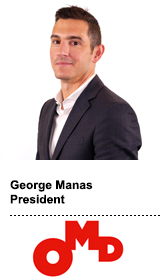
Agencies can no longer plan digital and linear investments separately.
Integrating planning strategies and investments at OMD will be a core focus for George Manas, who joined as president last week from Omnicom performance agency Resolution Media.
“I’ve been bullish on making sure programmatic talent doesn’t live in just an activation or investment capacity alone,” he said. “We’re bringing those resources much further upstream into the planning organization.”
OMD welcomed 440 programmatic experts from Resolution as part of a reorg in March. Those buyers will sit side by side with traditional buyers on client teams to collaborate on integrated investment strategies, rather than being siloed off.
“Programmatic is no longer a line item on the media plan,” Manas said. “It’s how media is increasingly planned and bought. That’s a giant reason why we’re integrating those competencies into OMD.”
As OMD blends its planning and buying teams, it also intends to use its leverage as the world’s largest media agency to influence how the integrated video marketplace evolves.
“OMD is one of the top video spenders globally,” Manas said. “That gives us an absolute license to be a transformative force in how the video marketplace shapes up.”
He spoke with AdExchanger.
AdExchanger: How is OMD integrating programmatic into the planning process?
GEORGE MANAS: We launched a planning workflow to put new data capabilities at the forefront of the process. There’s been a pretty significant disconnect between the data that you plan with and the data you buy with. Historically, it’s qualitative and demographic data for planning and behavioral data for media segmentation and targeting. Our process links those two together so we can quickly and with high fidelity move from a plan to activation.
Why is there still a gap between those two data sets?
We have to broaden our aperture of planning and include communications, linear and advanced TV. Programmatic can be part and parcel of an upstream planning process, but it has remained relatively separate from the wider media plan. But programmatic just addresses one part of the media plan.
TV is not going away. It’s changing. As consumer attention continues to splinter across screens, this approach allows us to make better investment decisions in terms of how we optimize allocations within that mix. That’s allowing us to look at reach and frequency in a much more cumulative way, better calibrate our targeting strategies in a cross-screen manner and create new opportunities for storytelling in an audience- and context-specific way.
How is OMD approaching the advanced TV landscape as an integrated buying team?
We’re in the process of platforming our video planning and buying capabilities in concert with the advanced TV group at Omnicom Media Group (OMG). We’re creating a holistic data environment where we can link Mediaocean codes to digital delivery logs to get an impression-level view of the entire video delivery landscape.
We’re basically rearchitecting how video planning and buying gets done. We’ve brought together traditional and digital video planners and buyers to create an integrated investment organization around that. It’s a pretty fundamental shift.
How do you make sure the two teams are able to work with each other without inciting a turf war over video buying?
You remove political tension when you make everybody part of one team. The integrated investment organization will report up through me completely, so we’ve removed that wall.
We have a cross-screen initiative to get the organization trained up on a new planning approach, which will re-skill and cross-skill that entire team. Linear isn’t going away. We need to make sure digital techniques are infused in linear planning and buying. But the reach is increasingly within streaming, so we’re making sure we have the right diversity of skills.
What’s OMD’s approach to programmatic buying? Is the agency moving to a PMP-led buying approach like Hearts & Science?
OMD is among the largest programmatic spenders in the marketplace. We’re going to leverage that for our clients. OMG is well positioned given the investment we’ve made in inventory curation, data relationships and direct relationships with publishers. We are absolutely going to double down on PMP strategies that unlock new value and advantage for our clients.
If there’s anything the digital world has taught us over the last two years, it’s that context matters. Beyond just thinking about PMPs in terms of viewability, verification and price-based value, OMD will look to understand context as part of our value equation for investment. Can empathy give us a lens to evaluate the difference between a Facebook news feed ad and a streaming video ad. Context and content matter a hell of a lot more than we’ve given due.
Why is OMD just integrating programmatic talent into the organization now?
We’re at a tipping point. Consumer attention is increasingly fragmenting across screens and devices. There are a few outages within that, in planning, activation and measurement. Integrating these resources is absolutely critical to solving those outages. You can’t plan linear video separately from digital video today. We need an integrated resource model.
Consumers are getting slammed with over 3,000 marketing messages on a daily basis. To rebuild trust in advertising, conversations about programmatic, infrastructure, content and context all need to be linked.
This interview has been edited and condensed.
This post was syndicated from Ad Exchanger.


More Stories
AppLovin is Officially the New Target of Short Sellers
Is Tegna Looking to Hub Weather in Its Local Markets?
Stuff Group taps Belinda Francis to lead North Island Markets